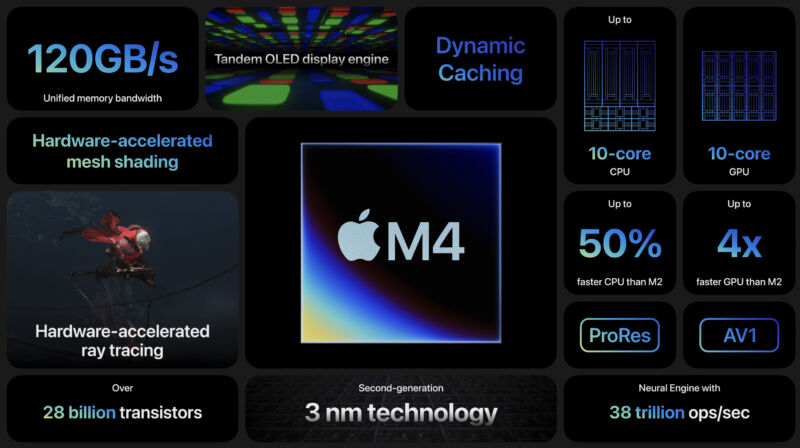
In a major shake-up of its chip roadmap, Apple has announced a new M4 processor for today’s iPad Pro refresh, barely six months after releasing the first MacBook Pros with the M3 and not even two months after updating the MacBook Air with the M3.
Apple says the M4 includes "up to" four high-performance CPU cores, six high-efficiency cores, and a 10-core GPU. Apple's high-level performance estimates say that the M4 has 50 percent faster CPU performance and four times as much graphics performance. Like the GPU in the M3, the M4 also supports hardware-accelerated ray-tracing to enable more advanced lighting effects in games and other apps. Due partly to its "second-generation" 3 nm manufacturing process, Apple says the M4 can match the performance of the M2 while using just half the power.
As with so much else in the tech industry right now, the M4 also has an AI focus; Apple says it's beefing up the 16-core Neural Engine (Apple’s equivalent of the Neural Processing Unit that companies like Qualcomm, Intel, AMD, and Microsoft have been pushing lately). Apple says the M4 runs up to 38 trillion operations per second (TOPS), considerably ahead of Intel's Meteor Lake platform, though a bit short of the 45 TOPS that Qualcomm is promising with the Snapdragon X Elite and Plus series. The M3's Neural Engine is only capable of 18 TOPS, so that's a major step up for Apple's hardware.
Apple’s chips since 2017 have included some version of the Neural Engine, though to date, those have mostly been used to enhance and categorize photos, perform optical character recognition, enable offline dictation, and do other oddities. But it may be that Apple needs something faster for the kinds of on-device large language model-backed generative AI that it’s expected to introduce in iOS and iPadOS 18 at WWDC next month.
The wait between the M1 and M2 and the wait between the M2 and M3 were each about a year and a half. With as few technical details as Apple has announced, it’s tough to know what to make of the faster turnaround between the M3 and M4. It could be that the M3 was behind schedule and the M4 was on time or ahead; it could also be that the M4 is a relatively modest architectural update to the M3. We'll need to test the hardware ourselves to determine exactly how the M3 and M4 stack up to each other.
The fast introduction of the M4 makes it a little clearer why Apple might choose not to update devices like the Mac mini with an M3 chip. Either the M3 processor generation will be uncommonly short, or Apple plans to sell a mix of M3 and M4 devices this year.
reader comments
154